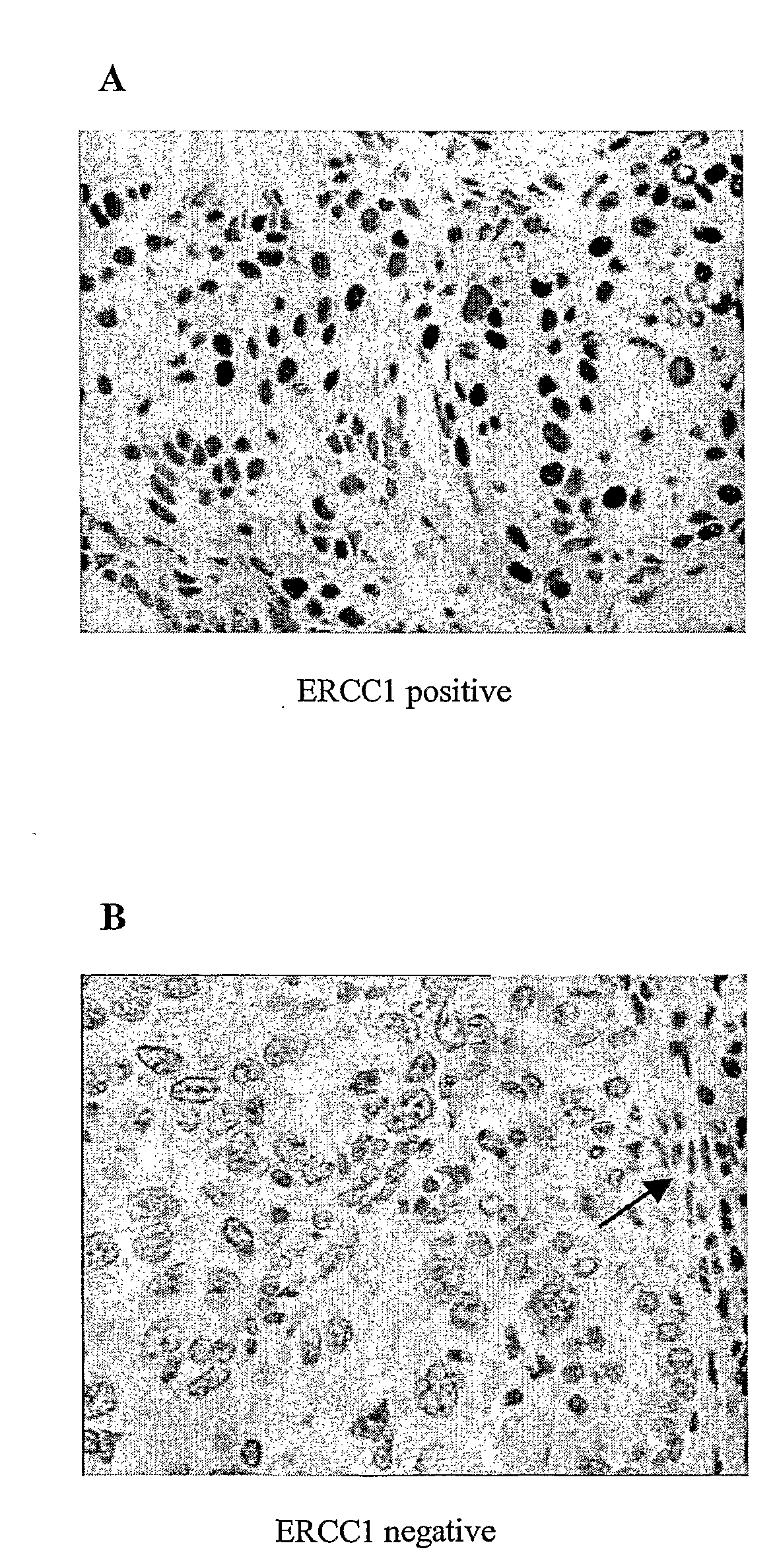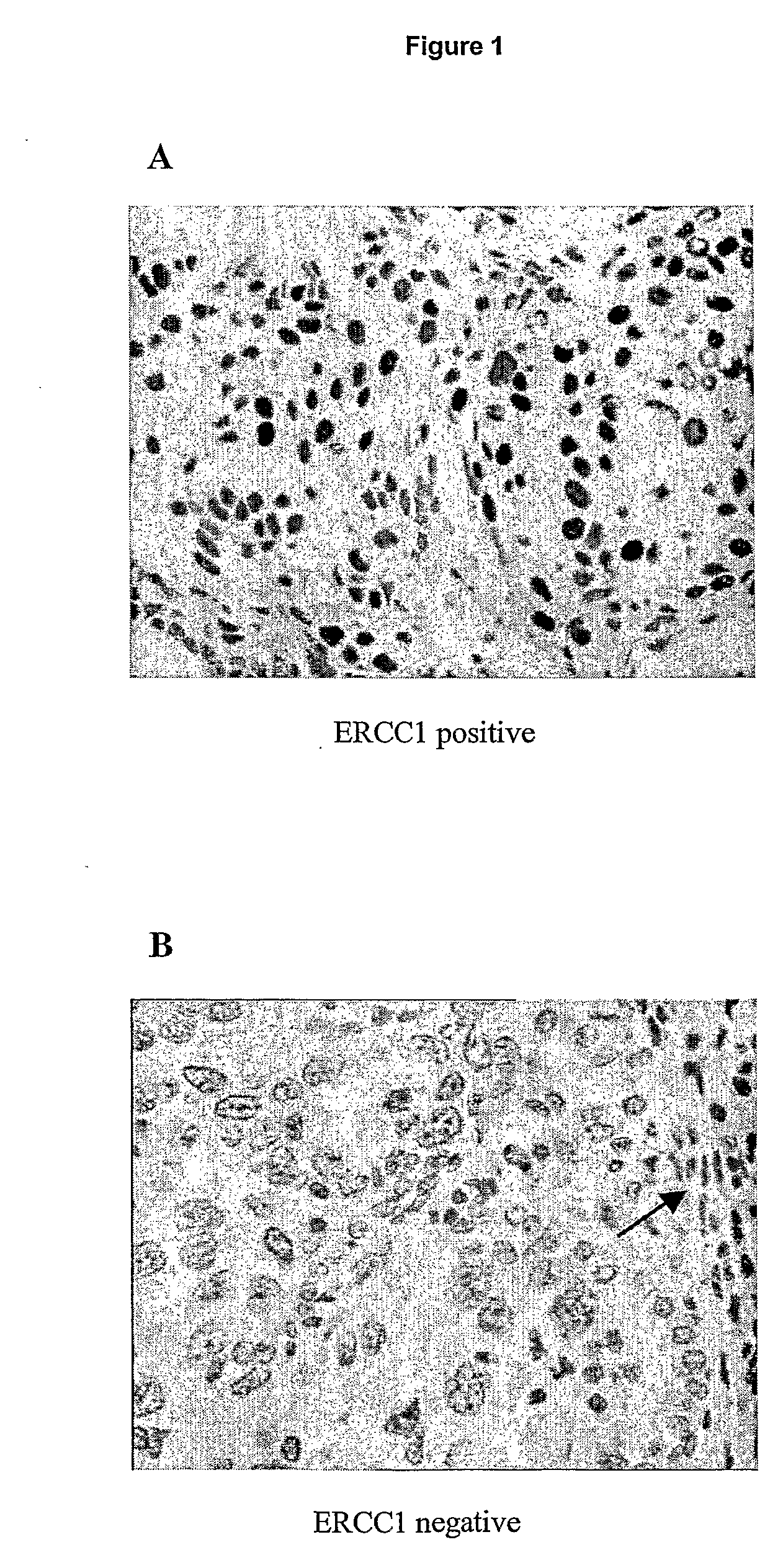Ercc1 expression in predicting response for cancer chemotherapy
a cancer chemotherapy and ercc1 technology, applied in the field of ercc1 expression in predicting the response of cancer chemotherapy, can solve the problems of low expression level, significant adverse effects, and only slightly prolonging the survival of adjuvant chemotherapy, and achieve the effect of convenient application
- Summary
- Abstract
- Description
- Claims
- Application Information
AI Technical Summary
Benefits of technology
Problems solved by technology
Method used
Image
Examples
example 1
Materials and Methods
Patients and Study Design.
[0045]All patients had participated in the IALT study that compared adjuvant cisplatin-based chemotherapy to observation in patients with non-small-cell lung cancer. Inclusion criteria and the results of the IALT have already been reported (The International Adjuvant Lung Cancer Trial Collaborative Group. Cisplatin-based adjuvant chemotherapy in patients with completely resected non-small-cell lung cancer. N Engl J Med 2004; 350:351-60), see table 1. Briefly, 1,867 patients with completely resected stage I-III non-small-cell lung cancer had been randomized to either chemotherapy with cisplatin (total dose 300-400 mg / m2) plus another drug (etoposide or a vinca alkaloid), or observation (control group). The median follow-up time was 56 months.
[0046]The IALT-Bio study was subsequently designed by a steering committee to examine whether immunohistochemically assessed tumor markers had the ability to predict a survival benefit from chemother...
examples 2
[0053]The 28 centers which participated in the IALT-Bio study included 1045 patients in the original IALT study. They were able to provide one tumor block for only 867 patients (83 percent). These 867 patients were comparable to the remaining 178 in terms of pre-randomization characteristics and overall survival. The amount and quality of the 824 blocks were adequate for serial sectioning. Among these blocks, 783 contained tumor material corresponding to non-small-cell lung cancer and were included in the IALT-Bio study. After exclusion of cases without valid positive internal controls, ERCC1 expression was evaluated in 761 cases. All further statistical analyses were based on these 761 patients.
[0054]The characteristics of the IALT-Bio study patient population are summarized in Table 1. A total of 426 cases were squamous-cell carcinomas (56 percent), 242 adenocarcinomas (32 percent), and 93 were of another histological type (12 percent). Median age was 58 yea...
example 3
Immunohistochemically Assessed ERCC1 Expression
[0055]As illustrated in FIG. 1, ERCC1 immunostaining was nuclear. The median value of the percentage of stained cells was 24 percent (range 0 to 100 percent), whereas the median value of H-scores was 1.0 Tumors with an H-score exceeding 1.0 (i.e. tumors with a staining intensity score of 2 and 50 percent or more positive nuclei or a staining intensity score of 3 and 10 percent or more positive nuclei) were deemed ERCC1 positive, which was the case in 335 patients (44 percent). The median H-score alone (1.0) was attributed to 164 tumors (22 percent). The main differences in clinico-pathological parameters according to ERCC1 expression are reported in Table 2 (univariate analysis). Using the multivariate logistic model, ERCC1 expression was significantly correlated with age (P=0.02 lower in young patients), sex (P=0.04 lower in females), pathological T status (P=0.04 lower with a higher T status), histological type (lower in adenocarcinom...
PUM
 Login to View More
Login to View More Abstract
Description
Claims
Application Information
 Login to View More
Login to View More - R&D
- Intellectual Property
- Life Sciences
- Materials
- Tech Scout
- Unparalleled Data Quality
- Higher Quality Content
- 60% Fewer Hallucinations
Browse by: Latest US Patents, China's latest patents, Technical Efficacy Thesaurus, Application Domain, Technology Topic, Popular Technical Reports.
© 2025 PatSnap. All rights reserved.Legal|Privacy policy|Modern Slavery Act Transparency Statement|Sitemap|About US| Contact US: help@patsnap.com



